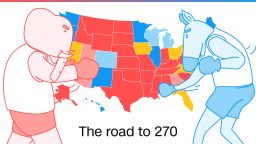There are few founding institutions in the United States less well-understood than the Electoral College, the somewhat mysterious body of officials who formally elect the nation’s president every four years.
You thought you would be voting directly for a presidential candidate? “One man, one vote,” as they say? It’s not that simple.
Where did the idea come from?
Instead of setting up a presidential election system through direct democracy, the nation’s founders established the Electoral College in part to ensure the entire nation has a more equal say in the choosing of a national president. In a time when the states were more autonomous and the federal government didn’t have as much power as it does today, the framers wanted to offset the chance that a single populous state or region would put forth a “favorite son” candidate that would almost exclusively represent the contender’s home state and disregard the needs of other parts of the country.
How many members of the Electoral College are there?
Today, there are 538 electors from all 50 states and the District of Columbia. The number of electors from each state is equal to the number of congressional seats the state has in the House and Senate. The District of Columbia was granted three electors by the 23rd Amendment, the minimum number. The people who make up the Electoral College are usually comprised of state party officials and generally chosen at the party’s state conventions.

Each party with a candidate on the presidential ballot puts forth a slate of electors. All but two states traditionally award the entire slate of electors to the candidate that receives a majority or plurality of votes. (The two states that do not follow this model, Maine and Nebraska, award two electoral votes to the candidate who wins the popular vote and then candidates receive another vote for each congressional district they win.) Some states require their electors to vote for the candidate who receives the most votes, but even in states where it is not required, Electoral College members rarely depart from the will of the people. The candidate who receives at least 270 Electoral College votes becomes the next president.
What does the current map look like?
Applied to the 2016 presidential race, the “Electoral College map” that shows electors from each state heavily favors Democrat Hillary Clinton because of the demographic realities in recent years. Densely populated and ethnically diverse states such as California, New York and Illinois, which pack a combined punch of 104 Electoral College votes – more than a third of the 270 votes needed to win – are virtually guaranteed to vote Democratic. Recent state polling also suggests that support for Republican Donald Trump has fallen away in states he would need to secure the presidency, leaving Clinton ample room for victory. The current CNN battleground map is featured below.
Clinton needs to pick up one battleground state to win
Based on that CNN Politics analysis, Clinton would need to win just one of the most sought-after states that are traditionally required for victory – such as Florida – to be elected president. If she just wins the states that are solidly or leaning Democrat in our current analysis, she’d win 268 electoral votes, falling just short of the White House. Clinton could win a battleground as small as New Hampshire to push her over 270. The map below shows what a Trump sweep of all battleground states except Florida and a Clinton victory would look like:
Trump must win all battleground states
In order for Trump to win, he would need to secure all of the states currently considered battlegrounds, including Florida, Arizona, Nevada, North Carolina and New Hampshire, which would put him at exactly 270. Here’s what a Trump winning map could look like:
Of course, much can change between now and Election Day. Nearly anything can happen in the final run-up to an election. One other hiccup in the math is that Maine and Nebraska distribute their Electoral College votes semi-proportionally, so either candidate could squeeze electoral votes from districts in those states.
What if there’s a tie?
You might have noticed that the total number of electors, 538, is an even number, which could, hypothetically lead to a tie. In this case, the House of Representatives would be called upon to choose the president. This has only happened twice in the nation’s history, when there was a tie between Thomas Jefferson and Aaron Burr in 1800 and a four-way split in 1824. It is extremely rare.
Can you lose the popular vote and still be elected president?
The use of an Electoral College system can also mean that a candidate can win the popular vote and lose the election. This occurred most recently in 2000, when Democrat Al Gore was defeated by Republican George W. Bush despite winning more votes nationwide.

